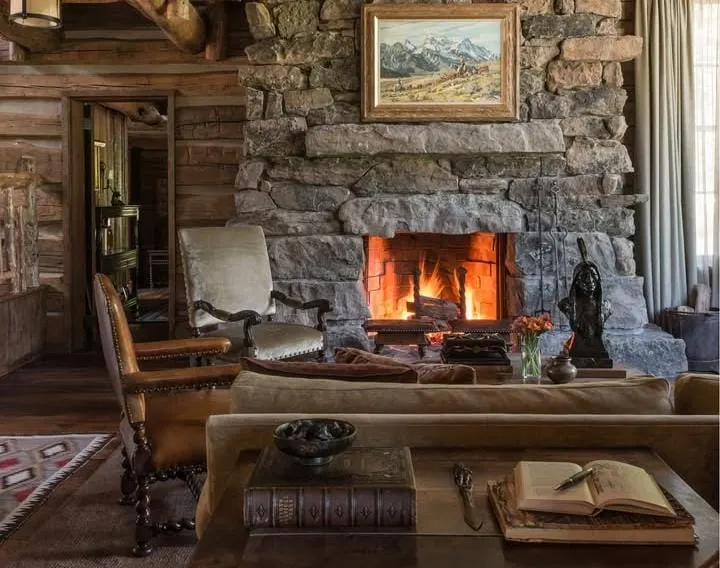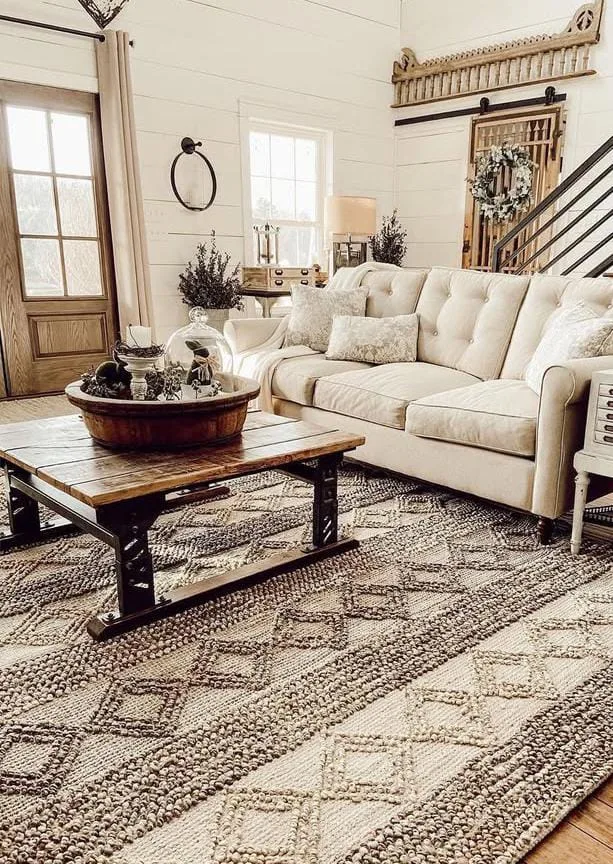20 Modern Open Floor Plan Living Room And Kitchen Ideas For Minimalist & Cozy Spaces
An open floor plan isn’t just a layout — it’s a lifestyle. It’s where connection, light, and freedom meet in one flowing space. The beauty of open floor ideas lies in their ability to make even the smallest homes feel grand while blending living, dining, and kitchen areas into one harmonious environment.
Whether you crave a minimalist retreat or a warm, inviting family zone, an open plan lets your design imagination unfold. With natural light spilling through large windows and furniture working as subtle dividers, every inch feels intentional and alive.
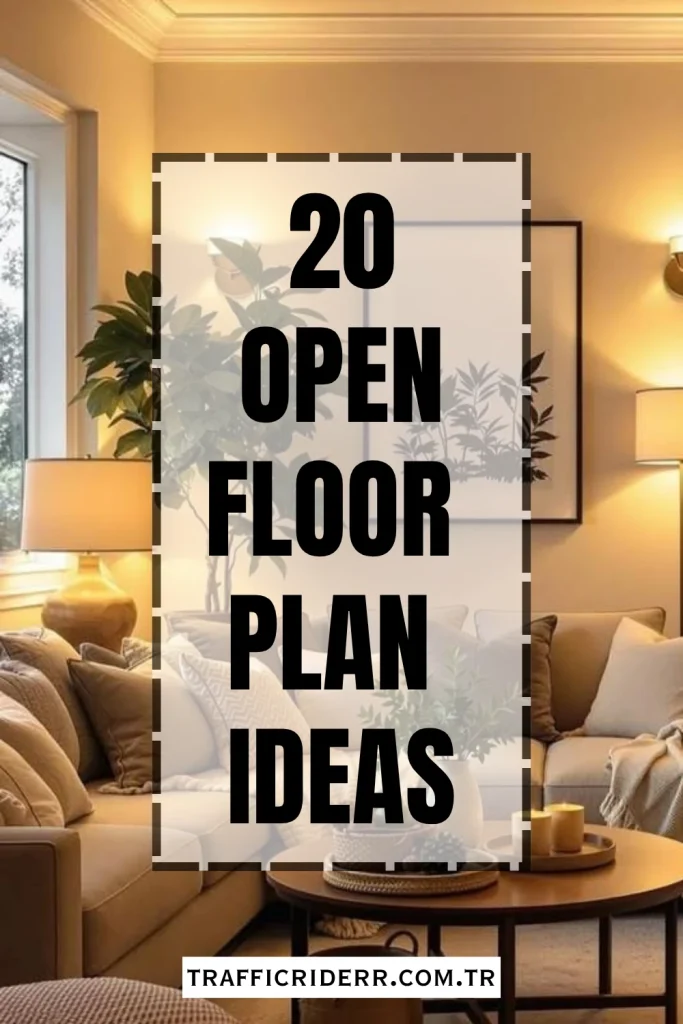
From cozy corners to sleek modern transitions, open floor living transforms a house into a story of movement and balance. This article explores 20 inspiring open floor ideas, each crafted to help you create a seamless, stylish, and truly personal home.
Also read: 15 Women Cave Ideas
The Magic of Flow — Why Open Spaces Feel So Inviting
There’s something liberating about walking into a room where walls don’t define your path. Open floor designs celebrate movement — from the morning coffee ritual to family evenings gathered around a shared space.
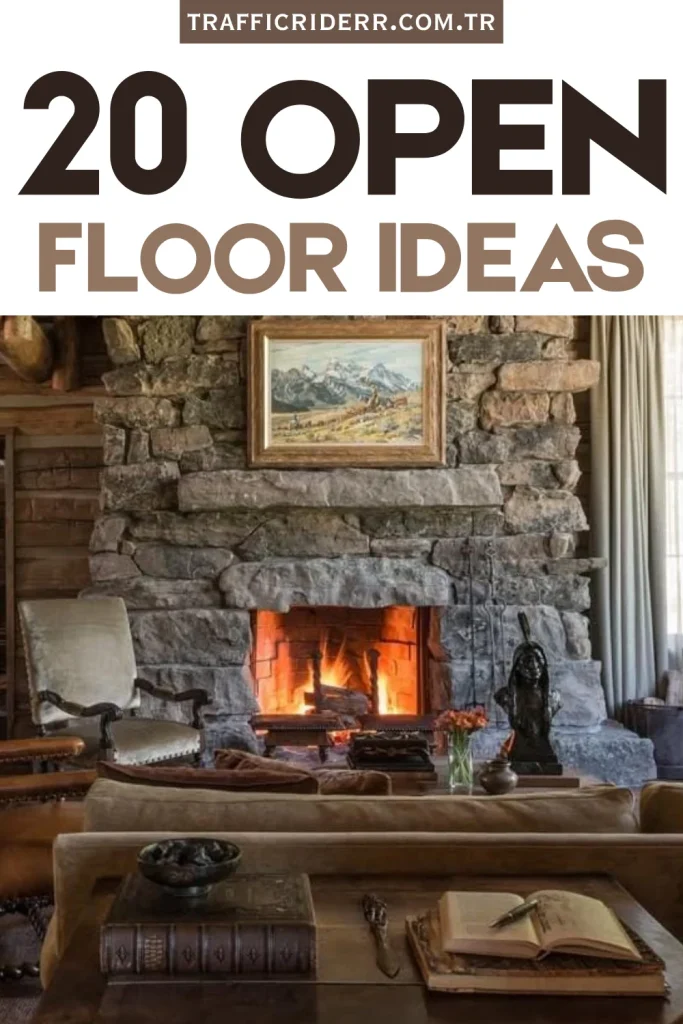
The layout allows every corner to feel part of something bigger, while furniture and textures build quiet boundaries without ever closing you in. Natural light becomes your décor ally, bouncing off finishes and surfaces to create a visual rhythm. It’s not just architecture — it’s atmosphere, designed to bring people closer and make daily living effortless.
Also read: Best Guest Room Ideas
Creating Connection Through Design
The beauty of an open floor concept lies in unity — how your living, dining, and kitchen areas speak to one another. Choosing consistent flooring, complementary color palettes, and flexible furniture pieces can tie everything together.

Think of your home as one cohesive canvas where small details like rugs, lighting, and plants gently shape zones of purpose. The goal is to balance openness with intimacy — a design that feels both spacious and grounded, elegant yet personal.
Table: Key Elements for Open Floor Harmony
| Design Element | Purpose | Tip for Styling |
|---|---|---|
| Flooring Continuity | Connects spaces visually | Use the same tone across rooms for smooth transitions |
| Lighting Layers | Defines zones subtly | Combine pendants, floor lamps, and recessed lighting |
| Area Rugs | Creates invisible boundaries | Anchor each zone with rugs of matching tones |
| Furniture Scale | Maintains flow | Choose low-profile pieces that don’t block sightlines |
| Color Palette | Ensures balance | Stick to 3–4 harmonious shades across the floor plan |
20 Open Floor Décor Ideas
Below are 20 open floor ideas, each designed to help you maximize flow, create comfort, and craft a home that feels endlessly connected. Each one includes detailed materials, clear step-by-step commands, and an explanation of the aesthetic and emotional benefits.
1. Seamless Flooring Transition
Materials/Tools: Matching tiles or wood planks, underlayment, floor adhesive, spacers, level, transition strips, sealant, finishing nails.

Instructions:
- Choose a flooring material that can run continuously through living, dining, and kitchen spaces.
- Prepare subfloors evenly before installation to ensure a smooth finish.
- Begin installation from the central area for symmetrical flow.
- Use a level and spacers to maintain alignment between sections.
- Avoid abrupt color or texture changes between rooms.
- Install transition strips only where necessary for structural reasons.
- Seal all joints and gaps neatly for water and dust resistance.
- Add soft rugs where zones subtly shift (e.g., dining area).
- Keep thresholds low to maintain uninterrupted sightlines.
- Consider radiant heat flooring for comfort and function.
- Finish with a matte sealant for modern texture.
- Let flooring cure fully before placing furniture.
- Clean and polish to reveal uniform shine.
- Style furniture atop without visual clutter.
- Maintain periodically with neutral polish for longevity.
Benefits:
Uniform flooring visually connects every area, giving your open floor a seamless, luxurious feel. It enhances flow, improves light reflection, and reduces the need for visual breaks. The space feels larger, calmer, and thoughtfully designed — a timeless foundation for any décor style.
2. Zoning with Area Rugs
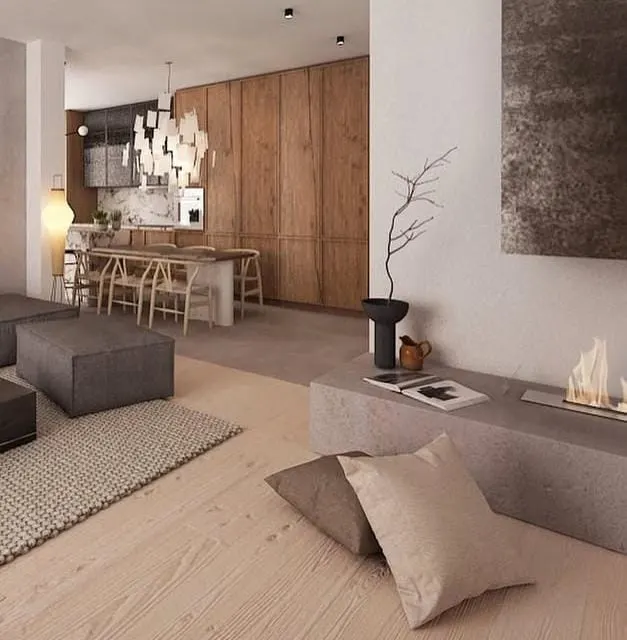
Materials/Tools: 3–4 rugs (wool or jute), rug pads, measuring tape, masking tape, vacuum, furniture sliders.
Instructions:
- Measure each zone — living, dining, kitchen — to determine ideal rug size.
- Use masking tape to visualize rug placement before buying.
- Select rugs in complementary colors but varying textures.
- Place a large rug under the sofa to anchor the living zone.
- Position a smaller, patterned rug beneath the dining table.
- Use a washable rug runner in the kitchen for practicality.
- Align all rugs parallel for visual order.
- Leave minimal floor gaps between rug edges to keep flow intact.
- Layer smaller rugs near cozy corners for texture.
- Use rug pads to prevent slipping or curling.
- Keep furniture legs partially on rugs to connect zones.
- Vacuum regularly to maintain fibers and color.
- Rotate rugs every few months for even wear.
- Add a small mat near entryways for function and style.
- Finish by blending rug tones with curtains or cushions.
Benefits:
Rugs define invisible boundaries while preserving openness. They add warmth, texture, and character, helping each zone feel purposeful without dividing walls. The layering effect enhances depth and visual comfort in open layouts.
3. Floating Furniture Layout

Materials/Tools: Sofa, console tables, armchairs, rug, floor lamps, painter’s tape, measuring tape.
Instructions:
- Plan zones by marking layouts with painter’s tape.
- Pull the sofa slightly away from walls to create “floating” effect.
- Position console tables behind seating for storage and definition.
- Use armchairs to shape conversational nooks.
- Add low open shelving to separate zones softly.
- Center each layout around a rug for anchoring.
- Ensure consistent walking space between pieces.
- Use floor lamps as vertical accents between zones.
- Keep sightlines open — avoid tall blocking furniture.
- Add a slim bench near windows for added flow.
- Maintain balance with symmetrical setups.
- Introduce accent tables where transitions meet.
- Test multiple angles for best natural light use.
- Secure furniture with felt pads to protect flooring.
- Review from all viewpoints for cohesiveness.
Benefits:
Floating furniture allows movement and breathing space, avoiding cluttered walls. It enhances flexibility, promotes natural flow, and keeps open spaces organized yet airy — perfect for social gatherings or quiet evenings.
4. Multi-Level Lighting Layers
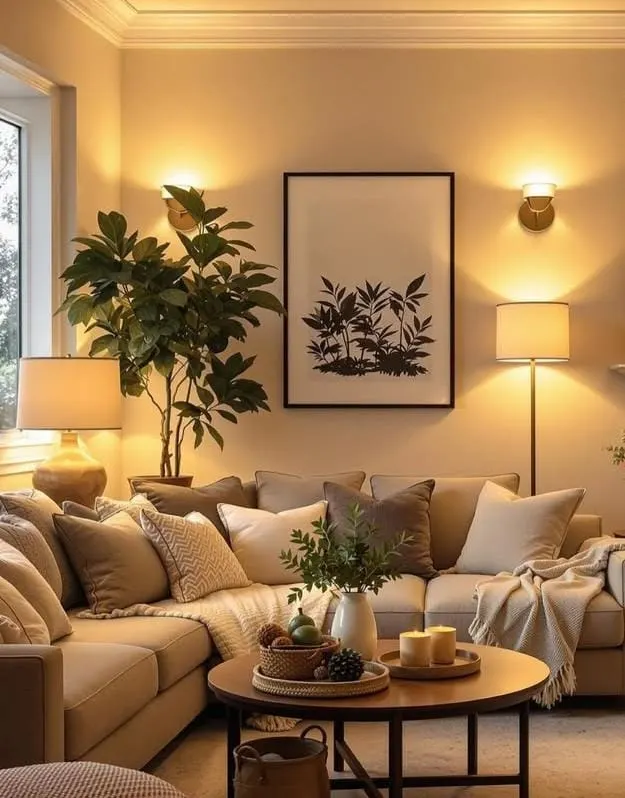
Materials/Tools: Pendant lights, track lights, table lamps, floor lamps, dimmers, extension cords, cable clips.
Instructions:
- Plan three layers: ambient, task, and accent lighting.
- Hang pendant lights above kitchen islands or dining zones.
- Install track lights for general illumination.
- Add table lamps near seating areas for cozy lighting.
- Use dimmers to adjust brightness per activity.
- Layer warm and cool bulbs for depth.
- Avoid harsh overhead glare with diffused shades.
- Position lamps to highlight art or focal points.
- Conceal cords neatly with clips or floor channels.
- Integrate under-cabinet lights in kitchens.
- Balance lighting intensity across zones.
- Add candles or lanterns for softness.
- Test nighttime lighting to ensure harmony.
- Use reflective surfaces to bounce light.
- Finalize by syncing tone temperature (2700K–3000K).
Benefits:
Layered lighting enhances visual zones, mood, and ambiance without barriers. It provides versatility for every moment — from bright family dinners to calm, romantic evenings. The overall design feels thoughtful, warm, and adaptive.
5. Glass or Sliding Dividers for Subtle Separation
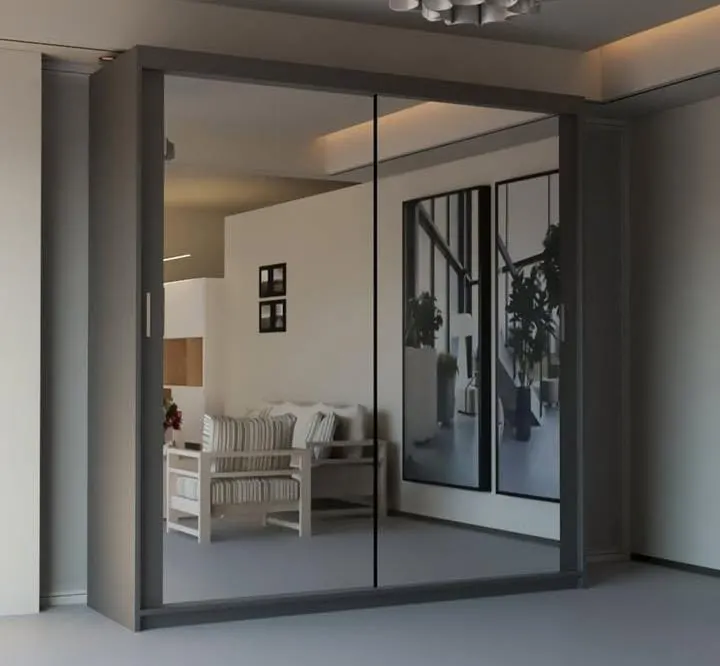
Materials/Tools: Tempered glass panels or sliding doors, measuring tape, track system, anchors, screwdriver, drill, level, sealant, curtain optional.
Instructions:
- Measure the width and height of the area you wish to subtly separate (e.g., between dining and kitchen).
- Choose tempered or frosted glass panels for transparency with privacy.
- Mark the ceiling line for track installation.
- Install the top track firmly with anchors and a drill.
- Slide panels into the track to test smooth motion.
- Apply sealant along edges for secure fit.
- Adjust rollers for even glide and alignment.
- If using curtains, install rods behind panels for added softness.
- Wipe glass clean with microfiber cloth to remove smudges.
- Use minimalist handles for aesthetic balance.
- Test daily operation to ensure stability.
- Add floor guides for panels to prevent swing.
- Incorporate small LED strips on frames for glow.
- Keep color tone neutral to blend with open plan.
- Finalize with decorative plants or wall lights beside dividers.
Benefits:
Glass or sliding partitions offer visual boundaries while maintaining light and openness. They enhance functionality without reducing airiness. The transparency creates rhythm and dimension — perfect for blending privacy and connection.
6. Ceiling Beams to Define Zones
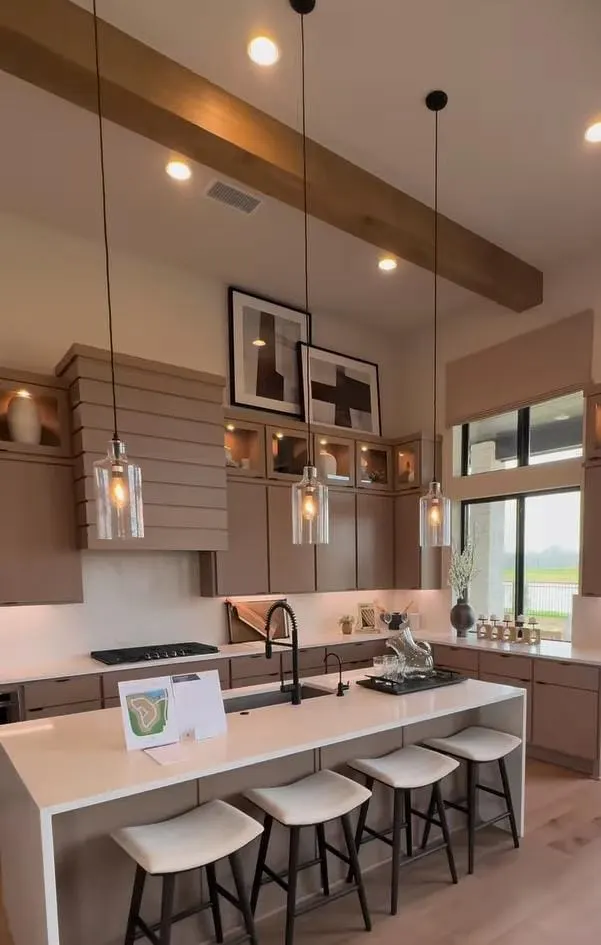
Materials/Tools: Faux or reclaimed wood beams, mounting brackets, nails, level, ladder, measuring tape, wood stain.
Instructions:
- Measure ceiling space to determine beam spacing.
- Use lightweight faux beams for easier installation.
- Mark beam positions across transitions like kitchen to living.
- Stain beams to match or contrast floor tones.
- Attach mounting brackets securely into ceiling joists.
- Lift beams onto brackets and lock into place.
- Use a level to ensure straight alignment.
- Caulk seams for a clean finish.
- Add recessed lights between beams for ambient illumination.
- Consider whitewashing for a rustic-modern mix.
- Dust beams regularly to maintain texture.
- Repeat along main living zone length for rhythm.
- Install cross-beams to frame smaller areas.
- Add decorative ceiling fans or pendants in beam gaps.
- Finish by sealing wood with protective coat.
Benefits:
Ceiling beams create natural visual breaks while preserving open air. They bring warmth, texture, and architectural presence. Perfect for adding depth to plain ceilings and tying together rustic or modern styles.
7. Central Island as Social Anchor
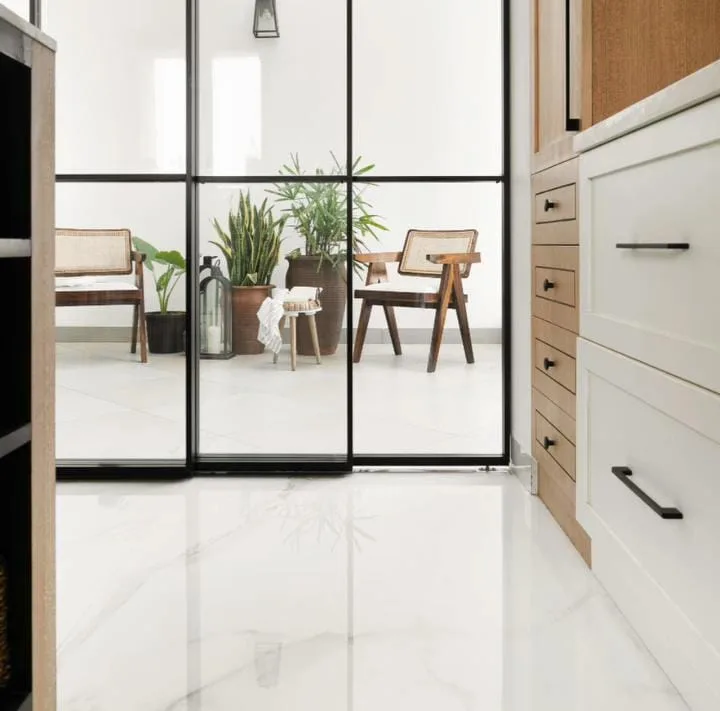
Materials/Tools: Countertop slab (granite, marble, or butcher block), base cabinets, bar stools, pendant lights, hardware, screws, level.
Instructions:
- Select an island proportionate to the open space.
- Install base cabinets securely in the chosen center area.
- Place countertop slab atop, aligning edges evenly.
- Secure countertop using construction adhesive.
- Install outlets on the side for convenience.
- Add pendant lighting overhead for task and mood.
- Choose stools that slide neatly under the island.
- Use one end as breakfast nook or bar area.
- Keep surfaces clutter-free for visual calm.
- Store cookbooks and baskets in open shelving beneath.
- Add flower vases or bowls as décor accents.
- Consider wheels for movable designs in smaller spaces.
- Use natural materials like oak or quartz for timelessness.
- Seal surfaces for moisture resistance.
- Clean regularly to maintain shine and hygiene.
Benefits:
The island serves as a communal hub connecting kitchen and living areas. It fosters conversation, meal prep, and casual dining while adding architectural balance. A well-placed island grounds the entire open layout.
8. Floating Shelves for Transitional Storage
Materials/Tools: Wooden planks, brackets, anchors, screws, drill, level, measuring tape, sandpaper, paint or stain.
Instructions:
- Select wall area that visually bridges two zones.
- Mark shelf placement evenly using a level.
- Drill pilot holes for brackets and insert anchors.
- Attach brackets securely to the wall.
- Cut wooden planks to match measured width.
- Sand edges for smoothness.
- Paint or stain to complement interior palette.
- Mount shelves onto brackets.
- Arrange books, plants, or decorative items neatly.
- Balance heavy and light objects across shelves.
- Avoid overcrowding for visual clarity.
- Add concealed LED strips under shelves for warmth.
- Regularly dust surfaces to keep neat.
- Style seasonally with new décor elements.
- Use shelves as soft dividers without blocking flow.
Benefits:
Floating shelves define transitions between living zones while maintaining openness. They combine beauty with practicality, enhancing style and offering flexible storage in airy layouts.
9. Biophilic Touches with Green Corners
Materials/Tools: Planters, indoor plants (pothos, ferns, fiddle leaf fig), soil mix, pebbles, watering can, tray stands.
Instructions:
- Identify bright corners across your open floor.
- Choose plants of varying heights for visual layering.
- Fill planters with soil mix and pebbles for drainage.
- Group plants in sets of three or five for balance.
- Position tall plants near seating areas.
- Use hanging planters above kitchen or dining zones.
- Add small tabletop pots for texture continuity.
- Keep plant containers in neutral or earthy tones.
- Place greenery near mirrors to double light reflection.
- Water regularly based on plant type.
- Rotate plants monthly for even sunlight exposure.
- Use trays under pots to protect flooring.
- Trim leaves to maintain shape.
- Add subtle grow lights for darker corners.
- Refresh with seasonal flowers or dried arrangements.
Benefits:
Biophilic décor brings freshness and life to open floor spaces. Plants soften sharp edges, improve air quality, and promote relaxation. The result is a natural, balanced atmosphere full of calm and connection.
10. Statement Lighting Above Key Zones
Materials/Tools: Chandeliers, pendant lamps, recessed lighting, dimmers, ladder, screwdriver, bulbs (warm white).
Instructions:
- Plan focal points — dining area, kitchen island, or sofa center.
- Choose one statement fixture per main zone.
- Mark ceiling points for accurate centering.
- Turn off power and install ceiling mount.
- Connect wiring carefully and secure canopy.
- Adjust fixture height to eye level for symmetry.
- Add dimmers for flexible brightness.
- Ensure matching metal finishes across fixtures.
- Combine pendants and recessed lighting for depth.
- Install soft warm bulbs for inviting ambiance.
- Clean glass shades before final setup.
- Align lighting direction to enhance flow lines.
- Highlight artwork or décor items strategically.
- Test at different times for tone harmony.
- Maintain fixtures regularly for clarity and shine.
Benefits:
Statement lighting anchors each open floor zone while unifying the overall design. It brings glamour, balance, and functionality — enhancing brightness, mood, and flow between shared areas.
11. Consistent Color Palette
Materials/Tools: Paint samples, rollers, trays, painter’s tape, primer, drop cloths, brushes.
Instructions:
- Choose a primary neutral color as your base (e.g., white, beige, or gray).
- Select two accent colors for personality.
- Paint walls across connected rooms in consistent tones.
- Use primer before applying top coats.
- Add depth with accent walls using muted variations.
- Match trims and moldings across spaces.
- Repeat key hues in furniture fabrics.
- Maintain consistent ceiling color for seamless continuity.
- Avoid sharp contrasts between adjoining walls.
- Blend accent colors in rugs and artwork.
- Use color testers to check daylight impact.
- Layer tones gradually to avoid flatness.
- Repaint annually to refresh brightness.
- Keep color transitions soft and flowing.
- Finish with matte for modern calm or satin for liveliness.
Benefits:
A unified color palette connects multiple areas effortlessly. It visually enlarges space, creates calm, and enhances architectural flow. Perfect for minimalist, contemporary, or farmhouse interiors.
12. Built-In Benches and Storage
Materials/Tools: Plywood sheets, screws, wood glue, saw, cushions, paint, measuring tape.
Instructions:
- Identify underused corners or window walls.
- Measure for bench depth and height.
- Cut plywood to fit space.
- Assemble base using wood glue and screws.
- Install hinged lids for hidden storage.
- Sand edges and smooth surfaces.
- Paint or stain to match room tone.
- Add plush cushions for comfort.
- Style with throws and accent pillows.
- Store blankets or books inside.
- Use baskets to organize smaller items.
- Install soft-close hinges for quiet use.
- Add nearby wall hooks for coats or bags.
- Finish edges with trim for polish.
- Keep area decluttered for clean visuals.
Benefits:
Built-in benches combine comfort with utility while keeping the open space neat. They create casual seating zones and maintain aesthetic cohesion. Perfect for maximizing small-space living.
13. Layered Textures for Warmth
Materials/Tools: Throw blankets, linen curtains, jute rugs, rattan baskets, velvet cushions, wool ottomans, wood trays.
Instructions:
- Start by identifying the key areas where people gather most — sofa corners, dining edges, or reading spots.
- Layer a large neutral jute rug as your base texture.
- Add linen curtains to soften windows and diffuse light.
- Mix smooth finishes (like metal frames) with soft textiles (like knits or wool).
- Drape throw blankets over sofa arms or benches casually.
- Combine cushions of various fabrics — velvet, cotton, or burlap.
- Introduce wooden trays on coffee tables for warmth.
- Use rattan baskets to hold magazines or extra blankets.
- Add wool ottomans to anchor conversation zones.
- Keep a consistent color palette throughout the layers.
- Avoid over-decorating; maintain visual breathing space.
- Use woven placemats or textured ceramics in the dining zone.
- Blend matte and glossy finishes to add depth.
- Rotate accessories seasonally for freshness.
- Light candles or place diffusers to engage the senses fully.
Benefits:
Layering textures adds emotional warmth and richness to open floors. It invites comfort and visual balance without clutter. The space feels lived-in, authentic, and harmonious — a perfect blend of modern openness and cozy tradition.
14. Sliding Barn Doors as Flexible Dividers
Materials/Tools: Wooden barn door slab, sliding track kit, anchors, screws, drill, handles, stain or paint, level.
Instructions:
- Measure the doorway or partition area where the door will hang.
- Choose reclaimed or new wood panels for a rustic-modern effect.
- Assemble the sliding track kit and mark drill holes on the wall.
- Drill anchors into studs to support weight securely.
- Mount the track and test glide movement before hanging.
- Attach handles and decorative hardware.
- Stain or paint the door to complement room colors.
- Install a floor guide to prevent door swing.
- Use barn doors between kitchen and dining zones for flexibility.
- Keep hardware minimal to maintain sleekness.
- Add soft-close mechanisms for quiet operation.
- Accessorize the door with wreaths or dried flowers for charm.
- Ensure track edges are aligned straight.
- Clean periodically to prevent dust buildup on rollers.
- Use matching barn doors in pairs for larger openings.
Benefits:
Sliding barn doors merge character and function beautifully. They let you control privacy without losing flow. Perfect for farmhouse or industrial aesthetics, they add movement and style in one effortless stroke.
15. Accent Walls that Anchor the Layout
Materials/Tools: Paint, painter’s tape, primer, drop cloth, brush set, wallpaper, level, ruler.
Instructions:
- Select one main wall that visually connects multiple zones.
- Choose a bold yet harmonious color or pattern.
- Apply primer before painting or papering.
- Tape edges neatly for clean borders.
- Use matte or satin finish for modern effect.
- If wallpapering, start from center and smooth out bubbles.
- Keep pattern scale balanced with surrounding furniture.
- Hang artwork or mirrors to enhance the focal point.
- Repeat accent color in nearby décor elements.
- Add sconces or directional lighting for emphasis.
- Maintain contrast subtly — not overpowering.
- Repaint or refresh wallpaper annually to retain crispness.
- Avoid accenting multiple walls; focus on one.
- Balance décor on opposite side for cohesion.
- Step back frequently to check proportional harmony.
Benefits:
An accent wall gives structure to an open layout without physical dividers. It draws the eye naturally, adds depth, and grounds furniture placement. It’s a perfect way to express creativity while maintaining cohesion.
16. Open Shelving Between Zones
Materials/Tools: Wooden shelves, metal frames, brackets, anchors, screws, drill, sandpaper, stain or paint.
Instructions:
- Measure the space between living and dining zones.
- Choose open shelving height that doesn’t block sightlines.
- Cut shelves to size and sand edges smooth.
- Attach metal frames or supports securely to floor and ceiling.
- Drill anchors into studs for stability.
- Stain or paint shelves in tones that match flooring.
- Install shelves evenly spaced.
- Arrange books, ceramics, or baskets sparingly.
- Add potted plants for life and texture.
- Keep middle shelf mostly open for transparency.
- Use under-shelf lighting for nighttime glow.
- Clean surfaces weekly to maintain openness.
- Avoid overcrowding; negative space is key.
- Style asymmetrically for interest.
- Adjust décor seasonally for freshness.
Benefits:
Open shelving maintains visual connection between spaces while organizing décor artfully. It defines boundaries gently, offering both storage and display without closing in the room.
17. Statement Ceiling Design
Materials/Tools: Paint, stencils, wood planks, beadboard panels, adhesive, ladder, level, trim.
Instructions:
- Clear the room or cover furniture with cloths.
- Clean and prime ceiling surface.
- Decide on texture: paint pattern, wooden beams, or paneling.
- Mark even gridlines using a level.
- Install beadboard or wood planks with adhesive and nails.
- Paint ceiling a subtle contrast to walls.
- Add trim around edges for polish.
- Incorporate recessed or pendant lights.
- For high ceilings, choose darker tones for coziness.
- Use stencils for creative geometric or floral effects.
- Caulk gaps and seams for a smooth finish.
- Repaint periodically to maintain clarity.
- Keep ceiling clutter-free of hanging items.
- Add a central medallion under a chandelier for grandeur.
- Clean gently to preserve finish.
Benefits:
A statement ceiling draws the eye upward, adding architectural drama. It balances large open layouts and ties the design together vertically. Perfect for adding depth and character without heavy décor.
18. Movable Furniture for Dynamic Layouts
Materials/Tools: Lightweight furniture pieces, caster wheels, floor protectors, rugs, measuring tape, felt pads.
Instructions:
- Choose modular or mobile furniture like ottomans and rolling carts.
- Add caster wheels to chairs or side tables for easy movement.
- Keep furniture lightweight but sturdy.
- Arrange layouts that allow easy transitions for hosting or daily living.
- Mark furniture zones with rugs for guidance.
- Keep storage flexible with movable consoles or benches.
- Ensure balanced spacing to avoid congestion.
- Rotate furniture seasonally for fresh energy.
- Use nesting tables for adjustable surfaces.
- Store extra chairs that can appear when needed.
- Maintain consistent color for harmony.
- Add handles or grips for practicality.
- Protect floors with felt pads.
- Test various layouts until natural flow emerges.
- Maintain openness by avoiding oversized items.
Benefits:
Movable furniture adds adaptability to open floors. It keeps spaces flexible for gatherings, holidays, or minimal living. Your home feels versatile, balanced, and always ready for life’s rhythm.
19. Cohesive Window Treatments
Materials/Tools: Curtain rods, sheer drapes, blackout panels, rings, measuring tape, brackets, screwdriver.
Instructions:
- Measure window heights across all connected zones.
- Choose one fabric tone for consistency.
- Install rods at ceiling height for elongation.
- Hang sheer curtains for daytime glow.
- Add blackout panels in sleeping or TV zones.
- Match rod finishes to light fixtures.
- Use tiebacks for soft framing.
- Ensure drape lengths skim the floor neatly.
- Layer textures — linen for softness, velvet for richness.
- Avoid overly patterned fabrics to maintain unity.
- Clean curtains regularly for freshness.
- Use blinds only in high-light areas if needed.
- Keep edges aligned across all windows.
- Adjust colors seasonally with throw pillows.
- Maintain symmetry and proportion visually.
Benefits:
Cohesive window treatments unify the entire open floor plan. They diffuse natural light beautifully and maintain design flow. The result is harmony, balance, and an effortless sense of connected calm.
20. Dual-Tone Furniture Accents
Materials/Tools: Paint, painter’s tape, brushes, primer, cloth, varnish, sandpaper.
Instructions:
- Select neutral-tone furniture like coffee tables or chairs.
- Sand surfaces gently to prepare for paint.
- Apply primer to ensure smooth application.
- Use painter’s tape to mark halves or sections for color split.
- Paint one section with bold accent tone.
- Keep the other half neutral for contrast.
- Let coats dry fully before removing tape.
- Apply second coat for consistency.
- Seal with varnish for durability.
- Repeat across key pieces like stools or benches.
- Keep accent tones consistent with your palette.
- Add complementary décor — cushions or frames — nearby.
- Balance bold accents evenly throughout the layout.
- Clean surfaces regularly to maintain polish.
- Replace colors seasonally for freshness.
Benefits:
Dual-tone furniture injects character without overwhelming the space. It breaks monotony, adds playfulness, and highlights focal points. Perfect for modern open homes that value creativity within calm.
Conclusion
Designing an open floor home is all about creating harmony — the art of connecting spaces while preserving personality. From seamless flooring to statement lighting, each idea here is crafted to bring rhythm, comfort, and purpose to your interiors. These 20 open floor ideas invite you to design with intention — to blur boundaries gracefully and let your space breathe with light, life, and meaning. Whether you’re planning a renovation or refreshing your décor, save this guide and start reimagining how openness can transform your everyday living.


